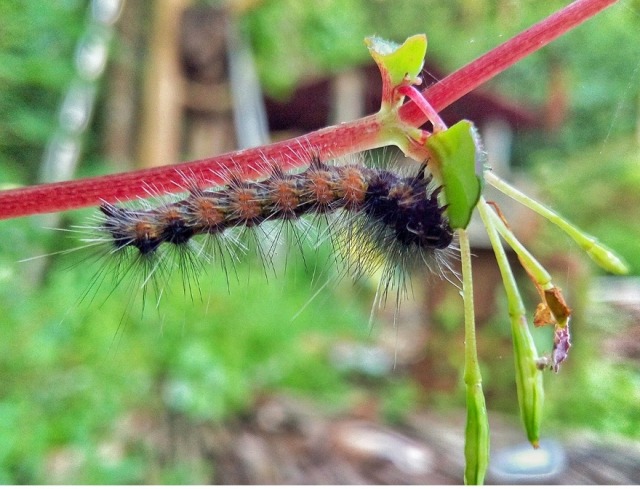by Timothy A. Pearce
When classifying organisms into broad categories, many people would group snails with insects rather than mammals. When it comes to diet, however, snails are much more like mammals than insects. That’s because, when choosing what to eat, insects tend to be specialists, while most mammals, and most snails, tend to be generalists. This pattern is especially striking when considering just herbivorous species.


Many herbivorous insects specialize on eating one or a few species of plants, and most often within a single plant family. For example, when we think of tent caterpillars, we expect to see them on cherry trees. In the caterpillar life stage of butterflies and moths, 69% of species feed upon just a single family of plants. If you look at just tropical butterflies and moths found within 25 degrees of the equator, the figure rises to 83% (Forister et al. 2015). Herbivorous mammals, on the other hand, tend to be generalists, eating a wide variety of plants from numerous plant families. Snails, it turns out, have broad diets including a variety of plants from numerous plant families, making snails more like mammals than insects, at least in their diets.
Of course, there are exceptions. While most herbivorous mammals are generalists, two mammals are famous diet specialists. Can you think of them? Hint: one eats bamboo, the other eats Eucalyptus leaves. Did you come up with panda and koala? Good for you! Similarly, while most insects are diet specialists, sometimes we do hear about plagues of locusts that have broad diets, so they eat practically every green thing in sight.
Most plants make chemicals that are not directly involved in growth or other metabolic functions. Scientists call these chemicals secondary compounds. In fact, secondary compounds are responsible for many of the distinct aromas and tastes in the spices we rely upon to flavor our cooking. But why would plants bother making secondary compounds that don’t directly benefit the plant? The most common hypothesis for why plants make secondary compounds is to protect the plants from diseases or herbivores.
Herbivores have ways (e.g., enzymes) to detoxify or reduce the effects of plant chemical defenses. Herbivorous insects that specialize on a few related species of plants can, over evolutionary time, develop strategies that effectively detoxify the defenses of those plants. Sometimes co-evolution results, an ongoing process in which the plant will modify its secondary compound to be more toxic, then the insect will develop the ability to detoxify that, and so on. The plant’s arsenal of chemical defenses protects it from the vast majority of herbivorous insects, but not the insects that specialize on that particular plant group. For example, milkweed is fed on by only a very few insects, including monarch butterfly caterpillars, that have countered its defenses.

In contrast to specialist insect herbivores, mammals tend to eat a wide variety of plant species. Consequently, mammals need general detoxification strategies that will protect them from a variety of plant secondary compounds. Thanks to detoxification enzymes located mostly in our livers and kidneys (Freeland & Janzen 1974), we can enjoy eating a wide variety of tasty plants without being poisoned.
Like herbivorous mammals, herbivorous snails also have general detoxification strategies, which might account for their large livers, where most of the detoxification occurs.
Now you know one way that snails are more like cows than insects: their diet!
Here is a joke about snails eating:
Two snails were munching a tasty salad made with a large number of different plants. One of the snails accidently dropped one of the exotic leaves from the salad. The other snail said, “You can still eat it, use the five-hour rule.”
Timothy A. Pearce is the head of the Section of Mollusks at Carnegie Museum of Natural History. Museum employees are encouraged to blog about their unique experiences and knowledge gained from working at the museum.
Literature Cited
Forister, M.L., Novotny, V., Panorska, A.K., Baje, L., Basset, Y., Butterill, P.T., Cizek, L., Coley. P.D., Dem, F., Diniz, I.R., Drozd, P., Fox, M., Glassmire, A.E., Hazen, R., Hrcek, J., Jahner, J.P., Kaman, O, Kozubowski, T.J., Kursar, T.A., Lewis, O.T., Lill, J., Marquis, R.J., Miller, S.E., Morais, H.C., Murakami, M., Nickel, H., Pardikes, N.A., Ricklefs, R.E., Singer, M.S., Smilanich, A.M., Stireman, J.O., Villamarín-Cortez, S., Vodka, S., Volf, M., Wagner, D.L., Walla, T., Weiblen, G.D. & Dyer, L.A. 2015. Global insect herbivore diet breadth. Proceedings of the National Academy of Sciences, 112(2):442-447; DOI: 10.1073/pnas.1423042112
Freeland, W.J. & Janzen, D.H. 1974. Strategies in herbivory by mammals: the role of plant secondary compounds. American Naturalist, 108(961): 269-289.
Related Content
Eating Shipworms to Save the World
Ask a Scientist: What is the biggest snail?
Cuttlefish Pass Marshmallow Test
Carnegie Museum of Natural History Blog Citation Information
Blog author: Pearce, Timothy A.Publication date: August 18, 2021
